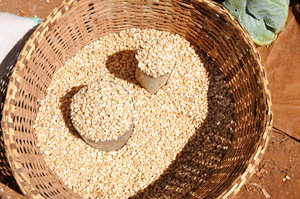HORN OF AFRICA: Greater food insecurity forecast
Food insecurity in the eastern Horn of Africa is expected to worsen as a result of less rain than previously forecast falling in the key March-to-May season.

Poor rains could further undermine food security
The US Agency for International Development’s Famine and Early Warning Systems Network (FEWS NET) warned that rainfall in this period would be 60-85 percent of the long-term average and that there was a 30 percent chance of the lower figure materializing.
“An expansion in the size of the food insecure population and an increase in the severity of food insecurity is likely,” FEWS NET said in an 3 April report.
The report warned of “significant impacts on crop production, pasture regeneration, and the replenishment of water resources” in a region that in 2011 suffered one of its worst drought-related food crises in decades.
March to May is the major rainfall season for pastoral and agricultural areas of northern Kenya and Ethiopia and parts of Somalia, and accounts for 50-60 percent of annual rainfall in the region.
In an effort to prevent future weather shocks translating into new humanitarian crises, the Intergovernmental Authority on Development (IGAD), a regional body, and international development partners, have launched an initiative to strengthen resilience in the region.
“We have mobilized funds [US$340 million] to support resilience programmes, and while the problems cannot be solved overnight, it is important to appreciate the need for long-term investments in such areas as education, water, and the need to identify problems early and deal with them in good time. People need to be helped to recover quickly from disasters,” Kristalina Georgieva, European commissioner for international cooperation, humanitarian aid and crisis response, told IRIN.
Political commitment from IGAD member countries, apart from development partners’ support, will play a crucial role in creating sustainable solutions to help people cope with the effects of the region’s recurrent droughts, according to Sileshi Getahun, Ethiopia’s minister of agriculture, in whose country some 3.2 million people are in need of humanitarian assistance.
Time to “stand up and be counted”
“We [regional governments] can’t talk about the same thing [drought] over and over and yet do nothing to help people. This is the time for regional governments to stand up and be counted,” Sileshi said.
Speaking to IRIN, the UK’s development minister, Stephen O’Brien, said: “Resilience programme support is an important part of humanitarian support and response and provides a more sustainable way to deal with disasters.”
Among things to be prioritized will be the provision of drought-resistant seeds, water, education, investing in weather forecasting technology, and scaling up nutrition programmes.
Solving the various conflicts in the Horn of Africa, which have seen thousands of people displaced and many more killed, will be crucial in improving the ability of people in the region to be resilient in the face of disasters, Mahboub Maalim, executive secretary of IGAD, told IRIN.
“In the face of disasters like drought and famine, people’s livelihoods are disrupted and efforts towards halting the various conflicts we see [in the Horn of Africa] cannot be ignored, because people can’t cope when conflicts persist,” he said.
Source: IRIN
- 499 reads
Human Rights
Fostering a More Humane World: The 28th Eurasian Economic Summi

Conscience, Hope, and Action: Keys to Global Peace and Sustainability

Ringing FOWPAL’s Peace Bell for the World:Nobel Peace Prize Laureates’ Visions and Actions

Protecting the World’s Cultural Diversity for a Sustainable Future

Puppet Show I International Friendship Day 2020

